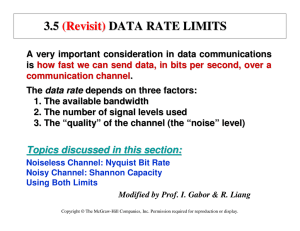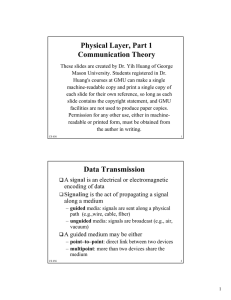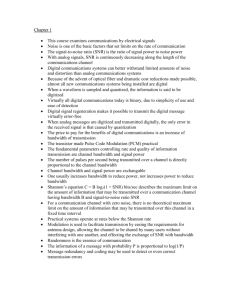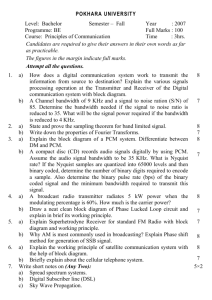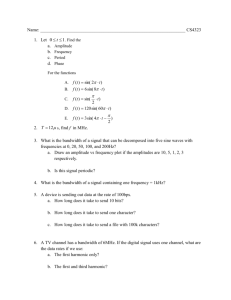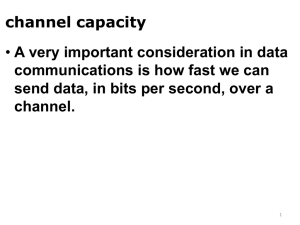ch3_4_v1
advertisement
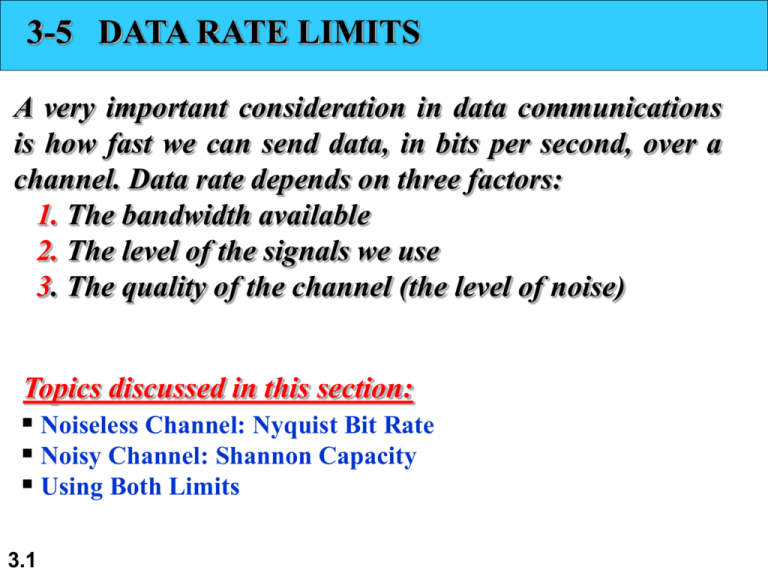
3-5 DATA RATE LIMITS A very important consideration in data communications is how fast we can send data, in bits per second, over a channel. Data rate depends on three factors: 1. The bandwidth available 2. The level of the signals we use 3. The quality of the channel (the level of noise) Topics discussed in this section: Noiseless Channel: Nyquist Bit Rate Noisy Channel: Shannon Capacity Using Both Limits 3.1 Note Increasing the levels of a signal increases the probability of an error occurring, in other words it reduces the reliability of the system. Why?? 3.2 Capacity of a System 3.3 The bit rate of a system increases with an increase in the number of signal levels we use to denote a symbol. A symbol can consist of a single bit or “n” bits. The number of signal levels = 2n. As the number of levels goes up, the spacing between level decreases -> increasing the probability of an error occurring in the presence of transmission impairments. Nyquist Theorem 3.4 Nyquist gives the upper bound for the bit rate of a transmission system by calculating the bit rate directly from the number of bits in a symbol (or signal levels) and the bandwidth of the system (assuming 2 symbols/per cycle and first harmonic). Nyquist theorem states that for a noiseless channel: C = 2 B log22n C= capacity in bps B = bandwidth in Hz Example 3.33 Does the Nyquist theorem bit rate agree with the intuitive bit rate described in baseband transmission? Solution They match when we have only two levels. We said, in baseband transmission, the bit rate is 2 times the bandwidth if we use only the first harmonic in the worst case. However, the Nyquist formula is more general than what we derived intuitively; it can be applied to baseband transmission and modulation. Also, it can be applied when we have two or more levels of signals. 3.5 Example 3.34 Consider a noiseless channel with a bandwidth of 3000 Hz transmitting a signal with two signal levels. The maximum bit rate can be calculated as 3.6 Example 3.35 Consider the same noiseless channel transmitting a signal with four signal levels (for each level, we send 2 bits). The maximum bit rate can be calculated as 3.7 Example 3.36 We need to send 265 kbps over a noiseless channel with a bandwidth of 20 kHz. How many signal levels do we need? Solution We can use the Nyquist formula as shown: Since this result is not a power of 2, we need to either increase the number of levels or reduce the bit rate. If we have 128 levels, the bit rate is 280 kbps. If we have 64 levels, the bit rate is 240 kbps. 3.8 Shannon’s Theorem Shannon’s theorem gives the capacity of a system in the presence of noise. C = B log2(1 + SNR) 3.9 Example 3.37 Consider an extremely noisy channel in which the value of the signal-to-noise ratio is almost zero. In other words, the noise is so strong that the signal is faint. For this channel the capacity C is calculated as This means that the capacity of this channel is zero regardless of the bandwidth. In other words, we cannot receive any data through this channel. 3.10 Example 3.38 We can calculate the theoretical highest bit rate of a regular telephone line. A telephone line normally has a bandwidth of 3000. The signal-to-noise ratio is usually 3162. For this channel the capacity is calculated as This means that the highest bit rate for a telephone line is 34.860 kbps. If we want to send data faster than this, we can either increase the bandwidth of the line or improve the signal-to-noise ratio. 3.11 Example 3.39 The signal-to-noise ratio is often given in decibels. Assume that SNRdB = 36 and the channel bandwidth is 2 MHz. The theoretical channel capacity can be calculated as 3.12 Example 3.40 For practical purposes, when the SNR is very high, we can assume that SNR + 1 is almost the same as SNR. In these cases, the theoretical channel capacity can be simplified to For example, we can calculate the theoretical capacity of the previous example as 3.13 Example 3.41 We have a channel with a 1-MHz bandwidth. The SNR for this channel is 63. What are the appropriate bit rate and signal level? Solution First, we use the Shannon formula to find the upper limit. 3.14 Example 3.41 (continued) The Shannon formula gives us 6 Mbps, the upper limit. For better performance we choose something lower, 4 Mbps, for example. Then we use the Nyquist formula to find the number of signal levels. 3.15 Note The Shannon capacity gives us the upper limit; the Nyquist formula tells us how many signal levels we need. 3.16
